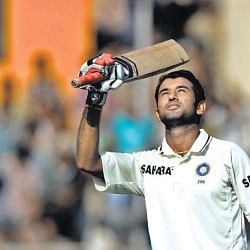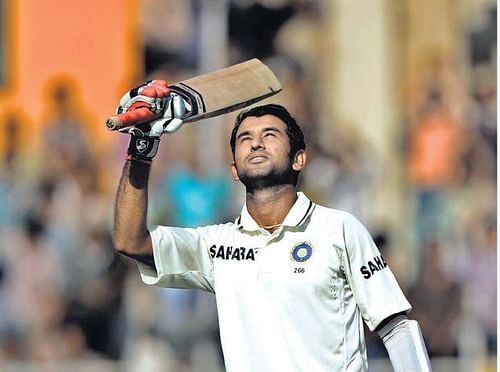
Indian selectors need to revert to 'horses for courses' policy

Cheteshwar Pujara needs to be drafted into the ODI side
The first leg of India’s tour of New Zealand has started on an abysmal note, with India not only losing the No.1 ODI ranking but also the series quite convincingly. Winning is a habit and India seems to have lost it at the moment. There were many factors for the humiliating series defeat, starting right from the selection of the team to amateurish on-field performances.
Sandeep Patil and Co. took some bold and, at that time, surprising decisions last year by dropping a couple of stalwarts for the home Test series against Australia. They had a similar approach when it came to the team selection for the Champions Trophy 2013, too. And to the surprise of many, results went in India’s favour as they white-washed the Aussies at home followed by winning the Champions Trophy without dropping a single game.
However, success seems to have brought in its own devil in the form of complacency. The selectors have stuck with the same formula for the two important tours, first to South Africa late last year followed by this tour to New Zealand, and the results are there for all to see. With the World Cup in Oceania just a year away, these two tours should have been an ideal starting point to figure out the best combination they would want for the quadrennial show piece event.
With around 15-20 ODIs in overseas conditions, a more pragmatic call would have been to go for “horses for courses” policy and unearth, from the domestic circuit, a seem bowling all-rounder, which Dhoni has been harping for two years now; one who could chip in with both bat and bowl. A seam bowling all-rounder can supplement the two spinners because playing two spinners might not always be a viable option in Australia and New Zealand next year.
Two options were available in the form of Stuart Binny and Rishi Dhawan (one of the leading wicket-takers in Ranji Trophy this season). While Binny did get selected for the tour to NZ, he was confined to the outfield in the one game that he got to play instead of being given a chance to prove himself with either the bat or the ball.
There was also a case for adding solidity at the top order in the form of either Cheteshwar Pujara or Gautam Gambhir, may be even both of them, particularly knowing that with two new balls and on pitches with a little more juice in it, old fashioned One-day cricket of keeping wickets at the end would help build or chase a healthy total. But, the selectors have sadly lacked the vision, which they promised earlier when teams for the home series against Australia and Champions Trophy were selected.
Selection bloopers aside, the squad selected should have delivered, but that was not the case. New ODI rules are stacked against the fielding side with only 4 fielders allowed outside the inner circle. It’s the bowlers who have to step up their skills and adjust at the international level. If the bowlers of a team ranked 8th at the start of the series can deliver, why can’t the same lot of No.1 ranked side? India has always been a batsmen dominated cricketing nation, but from an international side, leave alone a No.1 ranked team, one would expect that its bowlers would have their basics intact, which was horribly missing in Team India’s case.
Indian bowlers were like lambs to the slaughter, ready to be shred into pieces at any stage of the match. What was surprising is that even Nathan McCullum and part-timer Kane Williamson (combined economy rate of 4.99 with 6 wickets) fared better than their more celebrated Indian counter-parts Ravichandran Ashwin and Ravindra Jadeja (5 wickets at an economy rate of 5.20). How will India’s bowling woes get sorted? Only time will tell. Till such time, their batsmen will be sure of one thing i.e. to chase 300 plus totals.
Much was expected of the batsmen, who not long ago had chased 350 plus totals on concrete like Indian pitches with consummate ease. The most debated batting position in Indian cricket over the last six months has been the No.4 spot in both forms of the game. While Virat Kohli seems to have eased into the No.4 spot in the Test team, which was vacated by Sachin Tendulkar, it’s the No.4 spot in ODI team that has been a problem.
MS Dhoni defended his decision of giving Suresh Raina a go at No.4 for the ODI series against Australia at home, ahead of Yuvraj Singh, stating that he wanted an alternative option at that spot only to revert to Yuvraj for the ODI series which followed. Now that Yuvraj finds himself out of the squad, Ajinkya Rahane and Ambati Rayudu have been tried but without much success. So, who is the ideal No.4?
When India won the world cup in 2011, it was Virat Kohli who batted at No.4. There would be an argument as to why your best batsman must be disturbed. But Virat has an equally good record batting at No.4 (29 innings, 6 hundreds at an average of 62.57) as he has batting at No.3 (84 innings, 12 hundreds at an average of 52.63). This would also create a spot for a more solid batsman, when compared to the others who have been tried in the middle order, in the form of Pujara at No.3. And India would need solidity at the top in conditions where there is a bit of help for the new ball bowlers.
Talking of solidity at the top, Rohit Sharma and Shikhar Dhawan have been anything but solid in their outings outside the sub-continent. While Shikhar Dhawan’s problem has been more to do with technique, Rohit Sharma, after that one golden run in November 2013, seems to have gone back to his earlier habit of occasional brilliance and sustained stupidity. Throughtout the failed sojourn in South Africa and New Zealand, their batting has been one dimensional. They see off the good balls and hit boundaries in desperation, without looking out for quick singles, which was the hallmark of their partnerships in the UK during the Champions Trophy. Sooner they find a way the better for them and the team, or there would a case to recall Gautam Gambhir at the top provided he is fit and in form.
Indian fans can only hope that these defeats act as the tool for selectors, captain and the team management to take some tough calls and iron out the chinks in their armor for better results ahead.